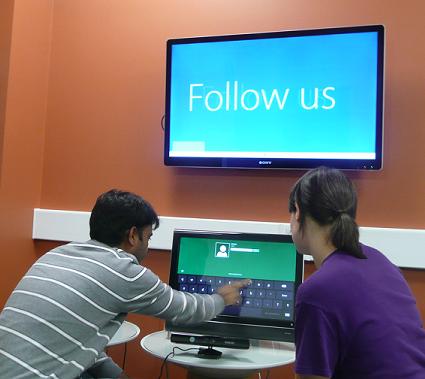
Bentley University Opens Computer Information Systems Learning and Technology Sandbox
Today’s students rely on technology for both their academic and social lives, and though some see it as a barrier to concentration in the classroom, others, like Mark Frydenberg are embracing it as a key teaching strategy. It was this core strategy and belief that propelled Mark to rethink the former CIS (Computer Information Systems) Tutoring Lab, and transform it into the CIS Learning and Technology Sandbox, a state-of-the-art learning space that opened this fall in the Smith Academic Technology Center, room 234, adjacent to the Trading Room.
“The term ‘sandbox’ in industry refers to an environment for experimentation and trying new things,” says Frydenberg, senior lecturer of computer information systems. “That’s our vision – to create an inviting, collaborative space for exploring and learning new technologies, and to support student learning for our courses in ways that resonate with today’s digital students.”
The new space incorporates a more modern design that encourages conversation and where learning takes place not facing a wall, but around small tables or in a lounge setting.
Today, says Frydenberg, it’s all about interaction. Google TVs, collaborative study spaces, large-screen TVs, a smart board, specialized networking equipment, and experimental software environments (such as Windows 8, Linux, and Android development software) are among current tools. Microsoft, in support of plans for the new facility, donated an Xbox and several software titles for student use, and is offering a series of special workshops on developing Xbox and mobile applications for Bentley students.
The layout is based on learning space designs found elsewhere at Bentley and other universities, but adapted for learning and for exploring technology and computer systems. Recognizing the growth of mobile and portable computing devices, the number of desktop computers in the room was reduced from 36 to 12, making more room for laptops and allowing students to collaborate on large screen TVs from their laptops, iPads, tablets and other devices. The Sandbox also relies heavily on social media platforms such as Facebook and Twitter to reach students. An interactive SMART Board nestled between working tables creates a casual learning area for small class activities, presentations, and workshops. A student created this short time-lapse video to summarize the construction that took place over the summer.
Beyond its physical presence, the Sandbox exists online as a web site (http://cis.bentley.edu/sandbox) where students can learn more about the facility, view a growing list of technology resources compiled by their peers, chat with staff on duty for help, learn from the blog posts of their fellow students, and connect via social networks.
The Sandbox hints at the university’s approach to run a learning facility like a startup business.
“When they are not helping students with their coursework, both undergraduate and graduate students are responsible for the publicity, management, software support, and day-to-day operations necessary to maintain the new facility,” Frydenberg explains. “The web site models the use of an open-source software tool ( Word Press), integrating industry standard web-based applications (such as Google calendar for coordinating staff schedules and eventbrite, for managing events), and provides student workers the opportunity to learn how to use these applications in an enterprise setting.”
There is more than 100 hours a week of student coverage for one-on-one or group assistance for students enrolled in IT 101 and other undergrad and grad CIS courses. Also in the works are student workshops on new technologies; among them are sessions on new features of Microsoft Office and how to use social media to promote student organizations.
Frydenberg observes: “The Sandbox will become the hub of student learning for CIS and IT courses on campus, as well as a place to have fun and explore new technologies.”

